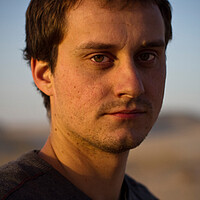Macedonia goes neo-classical – or is it just going kitsch?
Loading...
| Skopje, Macedonia
Walking along the bank of the River Vardar, Sashko Nikoleski points to some of the scores of new statues and neoclassical buildings that are now crammed into the Macedonian capital.
“I love these new statues. It’s our history and heritage,” he says.
Since 2010, the small republic of Macedonia, population 2.1 million, has been busy working on a redevelopment project that is literally remaking the heart of its capital. The plan is to turn the city from a forgotten corner of Europe into a cultural center that harks back to the glory days of Alexander the Great.
Over the last four years, towering new statues and imposing civic and governmental buildings have gone up, many featuring huge colonnades and other neoclassical touches. Center stage goes to a 72-feet-high statue of Alexander the Great, encircled by warriors and a fountain that performs a nightly light show. Across the Vardar, a statue of Philip of Macedonia, arm raised, stares back across the river. A €12 million ($16 million) Ferris wheel, reminiscent of the London Eye, is due to follow.
The project, named Skopje 2014 and set to be completed later this year, has been controversial from the start. Greece believes its northern neighbor is trying to usurp its history. In Macedonia, many view the project's aesthetic as kitsch and wasteful in a country where 30 percent of people live below the poverty line. And perhaps most troubling of all, Macedonia's ethnic Albanian population feels their contribution to Macedonian history is being brushed aside.
“Skopje 2014 is very divisive on ethnic and nationalistic lines, but also among most Macedonians,” says Saso Ordanoski, a political analyst and professor at the South East European University in Skopje. “There is a whole complexity to our nation identity, and this project is part of a populist kind of dream of Macedonia being one of the oldest nations.”
What's in a name?
Since gaining independence in 1991, Macedonia has struggled with its identity, right down to its choice of names. Greece has long claimed the name Macedonia as its own, referring to an area of northern Greece. So the country is officially the Former Yugoslav Republic of Macedonia (FYROM).
Some have seen Skopje 2014 as a way to confound Greece, as well as to try to bring more attention and tourists to the country by linking it strongly to Alexander the Great and other ancient warriors.
But Macedonia's myth-building may have a downside. “The feared consequence of Skopje 2014 is that its product will render ‘Macedonia‘ a negative brand, at best recognized as kitsch, at worst recognized as essentially inauthentic and counterfeit," wrote University of Virginia anthropologist Andrew Graan in a recent report.
Another major concern is cost: While officials say the budget is €200 million ($267 million), critics like Mr. Ordanoski claim that overall costs are likely to exceed €500 million ($668 million).
Ethnic tensions
The project has also contributed to simmering tensions between the Macedonian and ethnic Albanian populations. Last December, ethnic Albanians damaged a recently completed statue of Czar Dusan, an medieval ruler who Albanians see an oppressor. Many ethnic Albanians, who make up a quarter of the population, object to the single national narrative being promoted by the project and its lack of Albanian representatives.
“We don’t like any of this. We feel we are being pushed aside, like we are second class citizens,” says Jeton Iseni, an ethnically Albanian student, sitting among the new statues.
In late May, six people were injured and 27 arrested in riots apparently triggered by the arrest of an ethnic Albanian Muslim bike thief for killing a member of the majority Orthodox Christian population. In July, police clashed with protestors following the conviction of six ethnic Albanians over the deaths of five Christian fishermen back in 2012. [Editor's note: The original version misstated the event that triggered the May riots.]
As Skopje 2014 nears completion, it continues to divide Macedonia over its cultural legacy and role in society. “The new area is just about making money – it isn’t anything about culture,” says one older merchant in the Old Bazaar, the heart of the former Ottoman city, dismissing the new development. “That is one thing, this is another.”
Mr. Nikoleski disagrees. “Skopje 2014 will be great for Macedonia," he says. "With cheap flights and this new development more and more people will visit here and see our own culture.”







